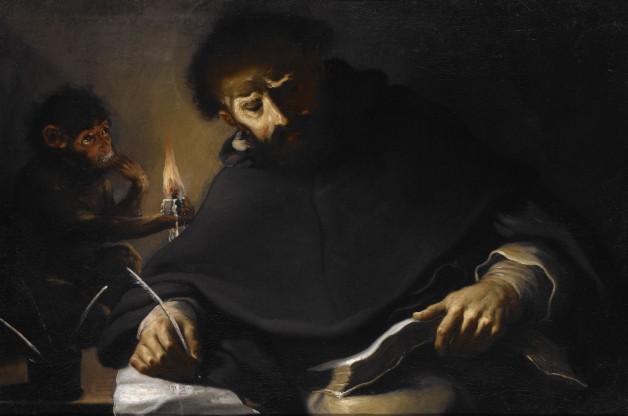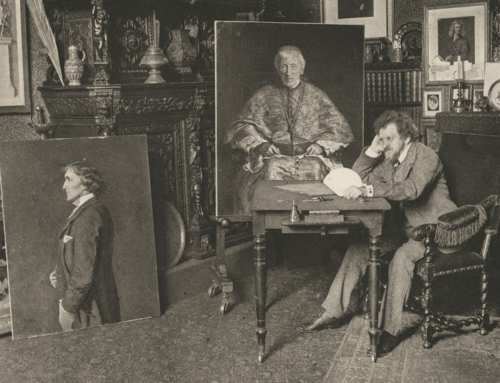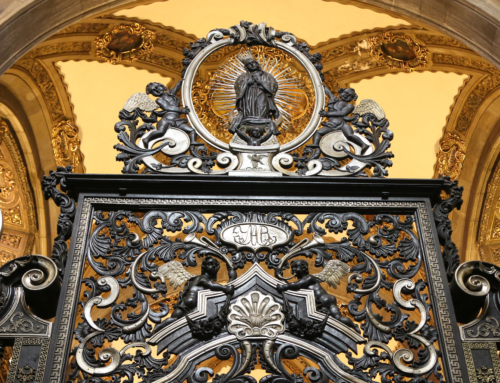I have always had a great love of monkeys. Whether cuddling a tender kitten, waiting patiently in a shearling coat in an IKEA parking lot, or riding backwards on a pig, monkeys rarely fail to bring a smile to my face as I contemplate the mischievous and yet reverent joy they seem to take in their existence. Although I’ve never had a monkey of my own—and probably never will, unless I am elected prior of an indulgent Dominican community—I take joy in these strange and marvelous creatures.
It is probably not surprising, then, to learn that one of my favorite depictions of St. Dominic is a painting which shows him reading by the light of a candle held by a small, mortified-looking monkey. This painting depicts a story about St. Dominic’s perseverance in study despite the temptation of the devil. One night, as Dominic was writing late at night in the dormitory—perhaps copying out French grammar paradigms so that he could preach more effectively to the Cathars of Toulouse—the devil appeared to him in the guise of a monkey, leaping and grimacing and reciting light verses.
Rather than putting down his quill to chase the monkey away, Dominic calmly advised the monkey that if it wanted to remain it ought to at least be useful and hold a candle. Apparently feeling obliged to comply with this fraternal correction, the monkey held the candle until the candle burnt all the way down to its little paws. After a further admonition failed to stop the monkey from howling out in pain, Dominic batted at the monkey with a stick until it departed, leaving behind a foul odor. Dominic himself appears to have taken some delight in this encounter: as the Lives of the Brethren recounts, “Sister Cecilia heard the blessed father tell this story to the brethren and sisters and saw him mimic the monkey’s gestures and grimaces.”
Although I take this story quite seriously, it perhaps possesses a sort of symbolic value in addition to its literal sense. In some ways, we have a similar experience when we start to become distracted or lose patience with our studies or other worthwhile activities. For St. Dominic himself, however, I think the story has an even deeper significance along with its amusing details.
Dominic was a great man—powerful in intellect, charismatic, able to attract and influence many men and women—and yet perhaps this greatness itself was at times a source of great temptation as well. Dominic surely did not fail to notice that he towered over many of his confreres and opponents with whom he engaged in disputations—how great must have been the temptation to take pride in this gift from God, or to trust in his own efforts rather than in the science of the saints. With his charismatic personality, how often must he have had to resist the temptation to manipulate or control those who eagerly gathered around him?
Perhaps the encounter with the monkey encapsulates these temptations, which—thanks be to God—Dominic was able to resist. In a way, Dominic was being invited by the devil to put aside his books—a symbol of the receptivity and intellectual dependence that accompanies true study—and devote himself solely to action which would flow from his own power and resources. In this case, this action would have seemed to be that of fighting the devil, but Satan is well aware that when we try to fight him by our own resources he has already achieved victory. Dominic, with all of his magnanimity, was being invited to grasp greatness on his own, rather than await the true greatness that flows from poverty of spirit. Instead, by the grace of God, Dominic continued to read and write by the flickering light of the monkey’s candle.
✠
Image: Pietro della Vecchia (1603-1678), St. Dominic and the Devil, Indianapolis Museum of Art







